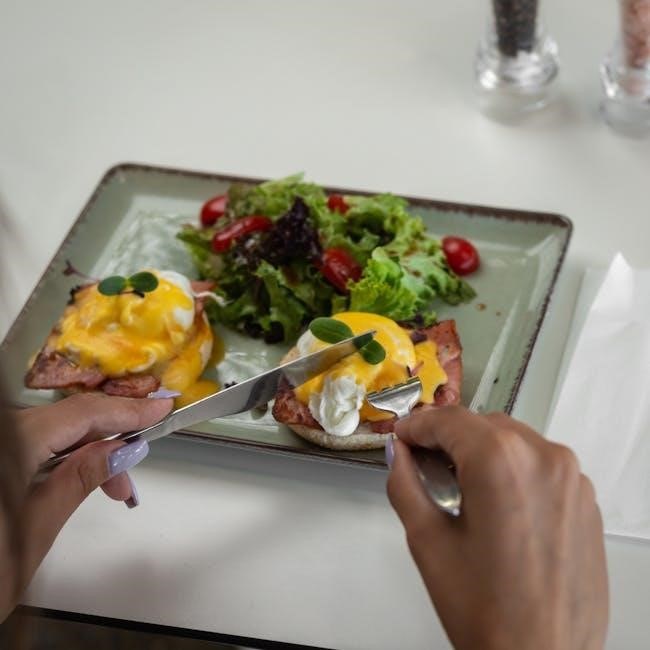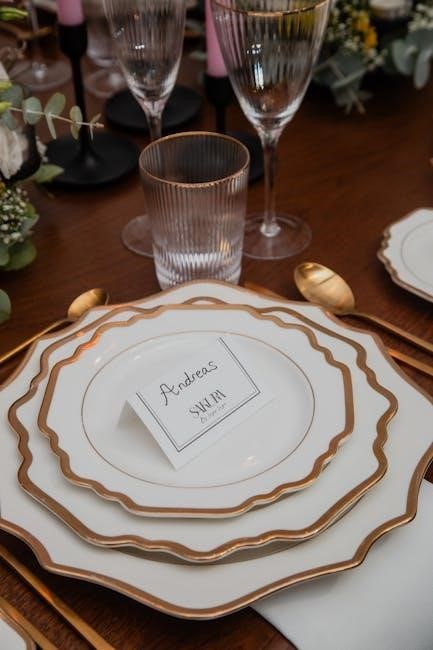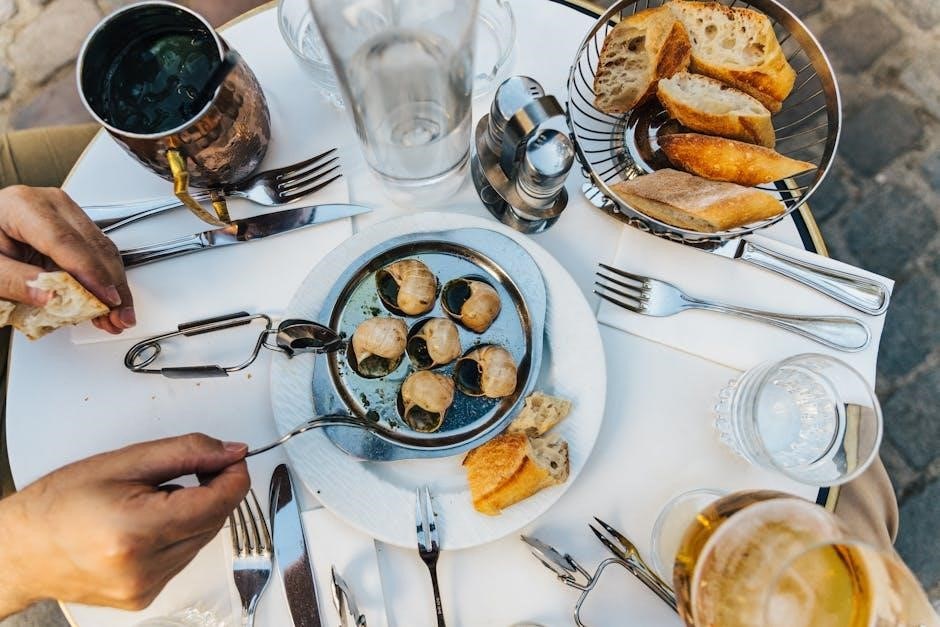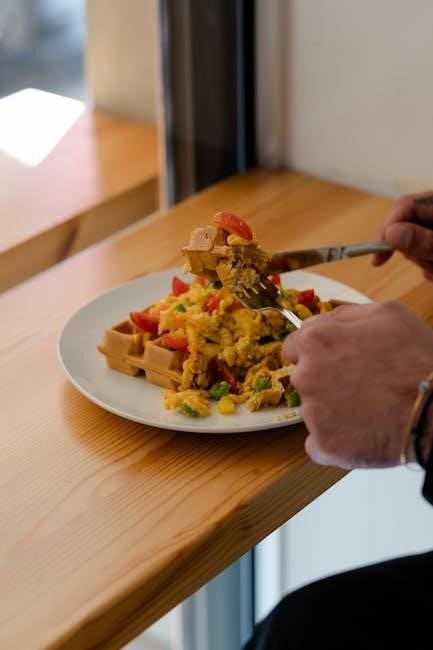
Knives are indispensable tools in every kitchen, offering precision and versatility for various cutting tasks. From chopping vegetables to slicing meat, a good knife enhances cooking efficiency and creativity, making it an essential instrument for both professional chefs and home cooks. Understanding the right knife for the job can elevate your culinary skills and transform everyday cooking into a enjoyable experience.

Types of Knives
From chef’s knives to paring, serrated, utility, and bread knives, each type is designed for specific tasks, ensuring precision and efficiency in various culinary applications.
Chef’s Knife
The Chef’s Knife, also known as a cook’s knife, is an essential tool for any kitchen. Its versatility allows for chopping, slicing, and mincing ingredients with precision. The blade typically ranges from 6 to 12 inches, with a curved edge that enables a rocking motion for efficient cutting. Often crafted from high-carbon steel or stainless steel, it offers durability and resistance to corrosion. Regular sharpening and proper care ensure its longevity and performance, making it a worthwhile investment for home cooks and professional chefs alike.
Paring Knife
A paring knife is a small, versatile tool essential for precision cutting. Typically 2 to 4 inches long, it excels at peeling fruits, coring vegetables, and trimming small items. Its compact size allows for precise control, making it ideal for detailed work. Often crafted from high-carbon steel or stainless steel, it ensures durability and sharpness. The ergonomic handle provides comfort during extended use. A must-have for both professional chefs and home cooks, the paring knife is a cornerstone in any kitchen setup.
Serrated Knife
A serrated knife features a saw-like edge, designed for cutting through tough or fibrous materials. Ideal for slicing bread, tomatoes, and meat, its teeth-like blades prevent tearing and ensure clean cuts. Typically 8 to 10 inches long, it is a must-have for any kitchen. The serrated edge requires less sharpening but benefits from occasional honing. Durable materials like high-carbon steel or stainless steel ensure longevity; Its versatility makes it a go-to tool for both everyday use and special culinary tasks.
Utility Knife
The utility knife, typically 4 to 7 inches long, is a versatile tool designed for various kitchen tasks. Its straight or serrated edge excels at slicing, chopping, and trimming ingredients like vegetables, meat, and herbs. Made from durable materials such as high-carbon steel or stainless steel, it combines strength and flexibility. The ergonomic handle provides comfort and control, making it ideal for both professional chefs and home cooks. A utility knife bridges the gap between a paring knife and a chef’s knife, offering precision and adaptability in the kitchen.
Bread Knife
The bread knife, typically 8 to 10 inches long, features a long, serrated blade designed for cleanly slicing bread without crushing it. Its sharp, toothed edge effortlessly saws through crusty loaves and soft pastries alike. Made from durable materials like stainless steel or high-carbon steel, this knife ensures even cuts and minimizes tearing. Ideal for both homemade and store-bought bread, the bread knife is a versatile tool that also works well for cutting soft fruits and cakes, making it a must-have in every kitchen.
Blade Materials
Blade materials like high-carbon steel, stainless steel, Damascus steel, and ceramic offer distinct durability, edge retention, and rust resistance, ensuring optimal performance for various kitchen tasks and preferences.
High-Carbon Steel
High-carbon steel is a popular choice for knife blades due to its exceptional durability and edge retention. It is highly prized by professionals for its ability to hold a sharp edge and resist wear. Knives made from high-carbon steel are easy to sharpen and maintain, making them ideal for heavy-duty tasks. However, they can be prone to rust if not properly cared for, requiring regular maintenance to preserve their quality and performance over time.
Stainless Steel
Stainless steel knives are renowned for their corrosion resistance and durability, making them a practical choice for everyday use. They are less likely to rust compared to high-carbon steel and require minimal maintenance. While they may not hold an edge as sharply, stainless steel knives are ideal for home cooks who prioritize ease of care and longevity. Their balanced performance makes them a versatile option for various kitchen tasks, ensuring reliability and consistency in cutting and slicing applications.
Damascus Steel
Damascus steel knives are prized for their distinctive wavy patterns and exceptional durability. Made from layered steel alloys, they offer superior edge retention and resistance to wear. The unique forging process creates a strong, flexible blade with a striking aesthetic. Damascus steel knives are highly valued by both professional chefs and collectors, combining functionality with beauty; They require proper care to maintain their performance but are a worthwhile investment for those seeking a high-quality, visually appealing knife.
Ceramic
Ceramic knives are renowned for their ultra-sharp edges and rust-resistant properties. Made from advanced zirconium oxide, they stay sharper longer and are lightweight for effortless cutting. Ceramic blades are ideal for precision tasks, like slicing vegetables or filleting fish. They are also non-reactive, preserving food flavors. However, they can chip if dropped and require careful handling. Ceramic knives are a great choice for those seeking a durable, low-maintenance option for everyday kitchen use.
Knife Anatomy
A knife’s anatomy includes the edge, spine, tang, handle, and bolster. These components work together to ensure balance, control, and precise cutting, enhancing overall performance and comfort.
Edge
The edge of a knife is the cutting part of the blade, designed for specific tasks. It can be straight, serrated, or a combination, each suited for different cutting techniques. A sharp edge ensures precision and efficiency, while a dull one can be unsafe. Regular sharpening and honing are essential to maintain the edge’s effectiveness. The edge’s angle and material greatly influence its performance, making it a critical feature in determining a knife’s overall utility and longevity in the kitchen.
Spine
The spine is the thick, unsharpened back of the knife blade, running along its length. It provides strength and stability, preventing the blade from bending under pressure. The spine also helps balance the knife, making it comfortable to handle. In some knives, the spine is designed for tasks like cracking bones or opening shells, adding functionality beyond cutting. A sturdy spine is essential for durability, ensuring the knife withstands heavy use and maintains its shape over time.
Tang
The tang is the part of the blade that extends into the knife’s handle, providing structural integrity and balance. It can be partial, extending partway, or full, running the entire length of the handle. A full tang generally offers greater strength and durability, making the knife less prone to breaking. The tang also contributes to the knife’s overall weight distribution, enhancing control during use. A well-designed tang ensures a secure and comfortable grip, essential for precise cutting and handling.
Handle
The handle is a crucial component of a knife, providing grip and control. It is typically made from materials such as wood, metal, or synthetic polymers, ensuring durability and comfort. Ergonomic design is key, with contours that fit the hand naturally, reducing fatigue during extended use. A secure handle allows for precise movements, making it easier to perform intricate cuts. The material and design of the handle significantly impact the knife’s overall balance and usability, enhancing the cooking experience.
Bolster
The bolster is a metal or synthetic component located at the junction of the blade and handle. It serves as a balance point, enhancing the knife’s stability and weight distribution. The bolster also acts as a guard, preventing hands from slipping onto the blade during use. This feature is particularly important for safety, especially during precise or forceful cutting tasks. A well-designed bolster contributes to the knife’s overall ergonomics and functionality, making it a vital element in both form and function.
Maintenance and Sharpening
Regular sharpening and proper cleaning are essential for maintaining knife performance. Use sharpening stones or electric sharpeners to keep edges sharp, and store knives in a dry place to prevent rust and ensure safety;
Sharpening Techniques
Sharpening techniques involve using whetstones, electric sharpeners, or steel rods to maintain a knife’s edge. Start with coarse grit for dull blades, then refine with finer grit for precision. Hold the knife at a 20-degree angle, dragging the blade from heel to tip. Consistency in angle and pressure ensures an even edge. Regular honing with a steel rod maintains sharpness between sharpening sessions, keeping knives in optimal condition for precise cuts and safe handling.
Honing
Honing is a maintenance technique that realigns the knife’s edge, maintaining sharpness without removing metal. Using a honing steel, glide the blade from base to tip at a 20-degree angle, repeating on both sides. This method corrects minor dulling and prevents edge degradation, ensuring precise cuts. Regular honing extends the knife’s sharpness, reducing the need for frequent sharpening. It is essential for maintaining knife performance and safety in the kitchen, keeping edges keen and reliable for various cutting tasks.

Cutting Techniques
Cutting techniques are essential for achieving precision and consistency in the kitchen. Proper methods transform tasks into enjoyable moments, ensuring safety and efficiency while preparing ingredients for any dish.
Julienne Cut
The julienne cut involves slicing ingredients into long, thin strips, typically 1/8 inch thick. It’s ideal for creating uniform shapes for salads, stir-fries, and garnishes. To achieve this, trim the ends of vegetables like carrots or zucchini, slice them into thin planks, and then cut these into strips. This technique ensures even cooking and a visually appealing presentation, making it a versatile skill for various culinary applications.
Dice
Dicing involves cutting ingredients into small, uniform cubes, typically 1/4 inch in size. This technique ensures even cooking and a balanced texture in dishes. To dice, slice the ingredient into thin slabs, stack them, and cut into strips before cubing. Uniformity is key for consistent flavor and presentation. Mastery of dicing enhances knife skills and is essential for preparing a variety of culinary dishes, from soups to salads and stir-fries.
Chop
Chopping is a fundamental knife technique that involves cutting ingredients into smaller, irregular pieces. It’s ideal for ingredients like onions, garlic, and herbs. To chop, place the ingredient on the cutting board, hold the knife firmly, and bring the blade down in a controlled, rocking motion. Keep the tip of the knife on the board for stability. Chopping ensures even distribution of flavors and textures in dishes, making it a essential skill for preparing a wide range of recipes.
Slice
Slicing involves cutting ingredients into thin, uniform pieces, often for presentations or even cooking. To slice effectively, hold the knife at a slight angle and use a smooth, even stroke. For meats, slice against the grain for tenderness. A sharp knife is crucial for clean, precise slices. This technique is essential for preparing ingredients like meats, cheeses, and vegetables, ensuring consistency in texture and appearance. Practice makes perfect in achieving evenly sized slices for professional-looking dishes.

Safety Tips
Always cut away from your body and use a stable cutting surface. Keep fingers curled and away from the blade edge to prevent accidents and injuries.
Handling
Proper knife handling is essential for safety and efficiency. Always grip the knife firmly, with a controlled yet gentle touch, ensuring fingers are curled away from the blade. Avoid placing hands near the cutting edge and never hold ingredients with the blade. Keep your eyes on the task and maintain a stable cutting surface. Store knives in a secure place to prevent accidents and injuries.
Storage
Proper knife storage is crucial for maintaining sharpness and safety. Use a knife block, magnetic strip, or protective sheath to store knives separately. Avoid storing them in drawers without protection, as this can cause damage or injury. Keep knives away from children and moisture to prevent rust. Regularly clean and dry knives before storage to maintain their condition. A well-organized storage system ensures longevity and readiness for use, while also reducing the risk of accidents in the kitchen.
Buying Guide
When purchasing knives, prioritize quality and fit. Consider blade material, handle comfort, and balance. Start with essential knives like chef, paring, and bread knives. Balance budget with durability for long-term value.
What to Look For
When selecting a knife, consider blade material, such as high-carbon steel for sharpness or stainless steel for durability. Handle material should be comfortable and durable, like wood or synthetic. A full tang enhances balance and strength. Look for a bolster for added grip safety. Ergonomics and weight distribution are crucial for comfort. Sharpness and edge retention are key, with a recommended 20-degree sharpening angle. Finally, choose reputable brands known for quality and craftsmanship to ensure long-term performance and value.

Budget Considerations
Setting a budget is crucial when selecting knives. Entry-level knives can be affordable and functional, while high-end options offer superior quality and durability. Mid-range knives often provide the best value, balancing performance and cost. Consider your cooking frequency and skill level to avoid overspending. While premium materials like Damascus steel are tempting, they may not be necessary for casual use. Allocate your budget wisely, prioritizing essential knives over specialty ones to build a practical collection that meets your needs.
Recommended Brands
When choosing knives, consider reputable brands known for quality and durability. Shun, Wüsthof, and Zwilling J.A. Henckels are top choices for premium options, offering exceptional craftsmanship. Victorinox, known for its Swiss Army Knives, provides reliable, budget-friendly alternatives. For Japanese-style knives, Misono and Miyabi are excellent picks. Bobby Flay’s signature knives also offer great value and performance. Investing in trusted brands ensures long-lasting performance and satisfaction, making them worthwhile additions to your kitchen arsenal.
Specialized Knives
Specialized knives are designed for specific tasks, offering precision and efficiency. Hunting knives, fillet knives, cleavers, and pocket knives cater to unique needs, enhancing functionality and versatility in various applications.
Hunting Knife
A hunting knife is a sturdy, versatile tool designed for field dressing, skinning, and preparing game. Its robust blade typically features a straight or recurve edge for precise cuts. Often crafted with high-carbon steel for superior edge retention, hunting knives prioritize durability and ease of sharpening. Ergonomic handles ensure a secure grip, even in wet conditions. Whether for camping or professional use, a hunting knife balances functionality and portability, making it an indispensable companion for outdoor enthusiasts and hunters alike.
Fillet Knife
A fillet knife is specifically designed for filleting fish and other delicate meats, featuring a long, slender blade with flexibility for precise cuts. Its sharp, beveled edge allows for smooth, even slices, while the rounded tip prevents accidental punctures. Typically lightweight with ergonomic handles, fillet knives are ideal for both professional and home use, ensuring clean separation of meat from bones and skin. Regular sharpening maintains its effectiveness, making it a vital tool for seafood preparation and cooking enthusiasts.
Cleaver
A cleaver is a heavy-duty knife with a broad, thick blade, designed for chopping through bones, meat, and tough vegetables. Its broadhead allows for powerful strikes, making it ideal for breaking down large cuts of meat or crushing ingredients like garlic. The cleaver’s weight and balance provide leverage, ensuring clean, efficient cuts. With an ergonomic handle for comfort and control, it’s a versatile tool for both professional chefs and home cooks, perfect for tasks that require brute force and precision.
Pocket Knife
A pocket knife is a compact, portable tool designed for everyday carry. With a folding blade, it offers convenience and safety, fitting easily into a pocket or bag. Its small size makes it ideal for tasks like cutting rope, opening packages, or trimming materials. Available in various designs, from classic to modern, pocket knives often feature multiple blades or additional tools like bottle openers or screwdrivers. They are practical companions for outdoor enthusiasts, professionals, and anyone needing a handy utility knife on the go.

Ergonomics and Comfort
Ergonomics and comfort are crucial for a knife’s usability, reducing fatigue and enhancing precision. Handles made from materials like wood, metal, or synthetic polymers are designed to fit naturally in the hand. A well-balanced knife with a comfortable grip ensures better control and safety. Features like rounded edges and a contoured design minimize strain, while a sturdy bolster provides additional support; A knife that feels right in your hand can elevate your cooking or outdoor experience, making every task more enjoyable and efficient.